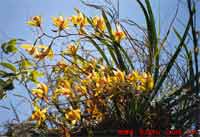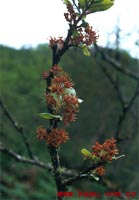Kingdom of Animals and Plants
Monsoon Rainforests - the Kingdom of Animals and Plants
 |
|
The refreshing daphne odora |
 |
|
orchis |
 |
|
orchis |
There are a lot of epiphytes in the monsoon rainforests. Plants of the orchid family can be seen everywhere. Golden-locks suspending downwards on the trunks of the trees and nest ferns growing on the tree forks look like the nests of birds. On the ground surface, people can see Habenaris, Arisaema, Primula and other grasses. There are activities of human beings in the Modog River valley. The people are all of Mamba or Lhoba people. Their villages are scattered or collectively located in the river valley terraces of different elevations and are isolated from the outside. The cane plantain woods, the canes and bamboos planted there seem to drip green in monsoon rains. Wild lemons, bananas and oranges also grow very well. Piece after piece of rice fields imbedded in the terraced fields on the river valley plains. The creeping vine crops and the early rice promise a rich crop. They are the materials for wine brewing for the local people. The big and golden pumpkins in the vegetable garden beside the village can grow as big as more than 5 kilograms. The red bright peppers are local products and the local people often use them to exchange other objects. In the monsoon rainforest environment of the low river valleys, there is a kind of humped cattle. It has a hatch on its back, which resembles that of a camel. There are also tigers here, a kind of Bengal tiger. On the way of our expedition, we also caught a king cobra that is hatching its eggs. We also saw rat snakes, searing iron snake, bungarus multicinctus, green bamboo snake, hornbill, sunbird and all kinds of tree frogs. Insects are even numerous, among which, there are many new species and newly recorded species. In the winter of 1998, we collected a kind of Zorotypus medoensis - the notchwing in Metog River valley in the northern slope of the Himalayas, which is a newly recorded geological distribution´
 |
|
Wild pepper |
During our expedition in Metog, we had to travel on foot all the way. I didn't imagine plants could bother our journey. Not only the vines mingling together were making our journey difficult or the darkness and humidity in the fog forest that were making it difficult for us to recognize the direction; there were dry leeches everywhere. They would attack people from all direction. They crawled all over our legs and we could neither tear them down nor throw them away. A kind of nettle would thorn into our legs when we were absent-minded and it also hurt the backs of our hands. The sores it gave us made it difficult for us to forget its existence for quite a long time. All these would give us spiritual burdens all the time. Of course, there were also some plants that would make us happy. Because we could eat their fruits when we were thirsty, such as wild oranges, wild bananas and water gourds etc. After all, the plants here are only an outline of the vegetations in Medog. As a matter of fact, the plants in Medog are more enriched, more colorful than what we could imagine, because Medog is the "Xishuangbanna of Tibet"and the kingdom of plants.

|